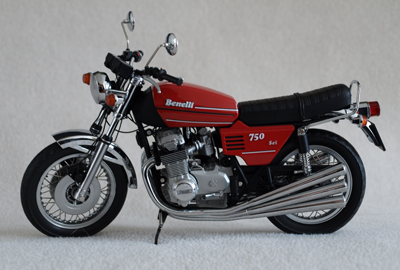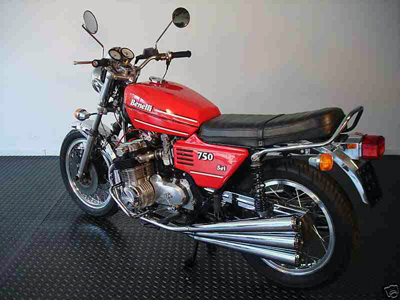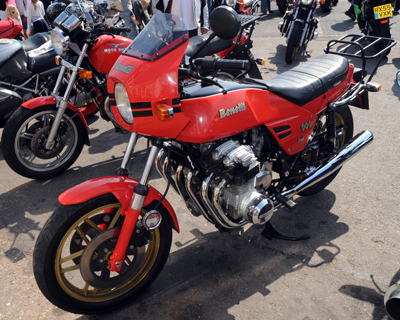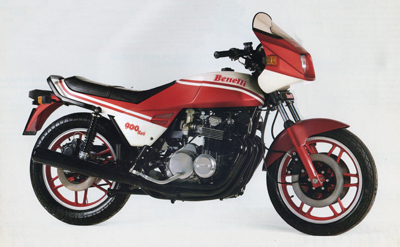|
History of the Benelli Sei Range:
The
750 Sei (Sei is Italian for six) was first
revealed to the public in 1972, the world's first 6 cylinder
production bike.
The 747.7cc bike produced 71bhp with
a bore & stroke of 56 x 50.6mm and became available for public
purchase in 1974.
It
was designed to assist Benelliís new owner to compete with
Hondaís ever popular CB500.
This breath of fresh-air-design was
wafted in by new owner Alejandro de Tomaso as he launched the
500 Quattro whose external engine castings had a remarkable
similarity to the Honda but internally was different and
recognised as superior.
De Tomaso decided he needed to lift
still further Benelliís game and added a cylinder to each side
of the 500 Quattro engine and made the 750 Sei; the worldís
first 6 cylinder road-going bike.
Anoraks please note - Honda up until
this time in its history had only built 6 cylinder race bikes,
the RC165, RC66, 2RC164 & 3RC164 range but no-doubt used this
race bike technology to launch their own CBX1000 roadie in the
late 70ís.
|
 |
Seiís
styling was similar to the Quattro but with a six into six
exhaust system making it instantly recognisable. The inline six
cylinder engine, with its three Dellorto carbs claimed 71 bhp
and a top speed of 118mph, which was not particularly impressive
for a superbike of the period. |
This
fact, combined with the high price of the bike, and the later
release of the Honda & Kawasaki 6ís meant that Benelli Sei sales
(during its production period of 1974-1989) were relatively poor
with an estimated world total of 5,000 bikes sold - 3,200 750ís
and 1,800 900ís.
|
|
There
is a perpetual motorcycle myth that Benelli copied Hondaís
engine design for their Quattro and Sei range so let us try
and put this into some perspective.
No modern day manufacturer in
his right-mind would dare to blatantly copy another
manufacturerís product because the legal costs and negative
publicity would be catastrophic especially someone with De
Tomasoís automotive experience and Hondasí commercial might.
|
I
would speculate that Benelli may had asked Honda to produce production designs to speed
up product-to-market-place but donít be mislead by this
speculation, Benelli had a lot of their own engine internal design
input.
Although a relatively small company, Benelli were major
engineering innovators and regularly copied by other
manufacturers, including the Japanese. |
For example, comparing a 500cc
Honda piston and conrod with the Benelli equivalent reveals similar
dimensions but better Benelli engineering by way of lighter
components for reduced reciprocating mass.
Similarly the Benelli inlet and
exhaust valve shafts are waisted above their heads to
improve gas flow in this area.
Benelli chose to use only three
Dellorto carburetors feeding 2 cylinders apiece in the
interest of narrowing this area for improved rider leg room. |
 |
 |
In 1978
Benelli launched the 900 Sei but still offered the 750 for a
short while. Cylinder bore was increased and the stroke
lengthened to 61 x 53.4mm equating to 905.9cc.
Benelliís excellent engineering
produced 900cc pistons weighing the same as the 750.
Power rose to 80bhp while top
speed questionably peaked at 130mph. The 750ís twin front
discs were retained and the rear drum brake became a disc,
hydraulically linked to one of the front discs as per their
now sister company Moto Guzzi.
|
Surprisingly the bike actually had a lower
dry weight than the 750, possibly due to less exhaust system
complexity. It had significantly different styling, with
molded GRP body panels concealing the fuel-tank and a more
conventional six into two exhaust system. A few were sold
without a fairing, but it soon gained the small (period)
round ĎGuzzi Le-Mans bikini style fairing, which was later
replaced by a trendy square looking Moto Guzzi fairing. |
|
Due
to Benelliís precarious financial situation, not all
production models were identical and turned into parts-bin
specials.
Generally the 900 Sei Mk Iís
were all red in colour, fairing-less in the beginning and
eventually sprouting the round bikini style fairing.
Detailed engineering
improvements continued particularly with the launch of the
Mk IIís.
These were similarly coloured
red but adorned with the later and squarer Moto-Guzzi
fairing.
Mk IIIís were similar to the MK
II but had a greater range of colour options.
|
The final version, the MK IV saw
further minor upgrades and a styling trend of the period,
towards an angular slash-style colour scheme, white over red
and white over black.
The old style insect-feelers
style chrome mirrors were replaced with car style door
mirrors, attached to the bikini fairing sides.
It had an unusual instrument
cluster and the exhaust system became (period, again)
black-chrome.
All in an attempt to up-date the
model and save production costs while attempting to regain
market appeal and improve sales volume to the
Ďheady-heightsí of 1979-1980 where 522 & 322 machines were
made respectively.
Sei production ceased in
1988/89. |
 |
|

